Samsung Galaxy Tab S9 Ultra vs iPad Pro — which tablet wins?
Apple's iPad Pro goes toe-to-toe with the new Samsung Galaxy Tab S9 Ultra
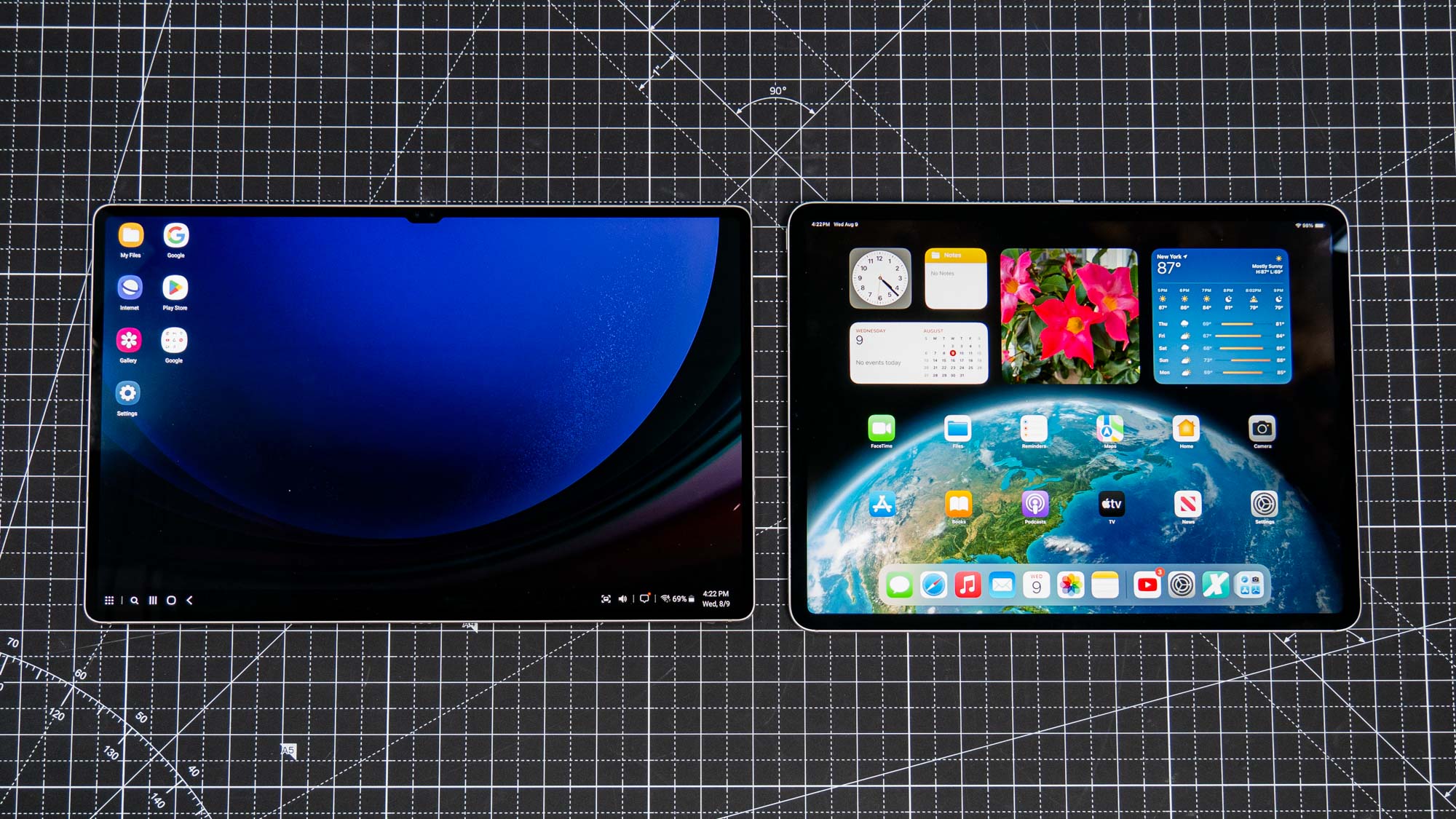
Disclaimer
Editor's note: This post was originally posted on August 11, 2023. Since then, Apple has released the iPad Pro M4. However, the iPad Pro discussed here is still on sale and still a viable option.
The Samsung Galaxy Tab S9 Ultra is here to literally tower over all other tablets.
Like its predecessor, the Samsung Galaxy Tab S8 Ultra, the new slate features an enormous 14.6-inch OLED display that commands attention. It also packs the new Qualcomm Snapdragon 8 Gen 2 chip found in Galaxy S23 series smartphones, which provides it with plenty of power.
That last point is important as the Galaxy Tab S9 Ultra can double as a laptop when paired with the Book Cover Keyboard, a use case Samsung is eager to promote via its Windows-like DeX mode.
With the Galaxy Tab S9 now available, you’re no doubt wondering how it compares to another large tablet: the 2022 12.9-inch iPad Pro. I’ve reviewed both the Samsung Galaxy Tab S9 Ultra and iPad Pro, so I have a solid handle on how the two tablets stack up against one another.
Which big tablet should you get? Read on to find out.
Samsung Galaxy Tab S9 Ultra vs iPad Pro: Specs
| Header Cell - Column 0 | iPad Pro 2022 (12.9 inch) | Samsung Galaxy Tab S9 Ultra (starting) |
|---|---|---|
| Price | $1,099 for Wi-Fi model | $1,299 for Wi-Fi + Cellular model | $1,199 |
| OS | iPadOS 16 | Android 13 |
| CPU | Apple M2 | Snapdragon 8 Gen 2 |
| RAM | 8GB RAM (128GB-512GB models), 16GB RAM (1TB-2TB models) | 12GB, 16GB |
| Storage | 128GB-2TB | 128GB-1TB |
| Display | 12.9 inches (2,732 x 2,048 pixels) | 14.6 inch (2,960 x 1,848) Super AMOLED, 120Hz |
| Ports | Thunderbolt 4/USB-C | Thunderbolt 4/USB-C |
| Rear Cameras | 12MP wide, 10MP ultra-wide | 13MP, 6MP ultra-wide |
| Front Cameras | 12MP TrueDepth | 12MP |
| Battery Life | 10 hours, 39 minutes (tested) | 9 hours, 27 minutes (tested) |
| Size | 11.04 x 8.46 x 0.25 inches | 12.85 x 8.21 x 0.22 inches |
| Weight | 1.5 pounds (Wi-Fi) | 1.51 pounds (Wi-Fi Cellular) | 1.61 pounds |
Samsung Galaxy Tab S9 Ultra vs iPad Pro: Price
The Samsung Galaxy Tab S9 Ultra is now available to pre-order starting at $1,199, with availability starting August 11. The entry-level model we reviewed packs 256GB of storage and 12GB of RAM, but you can pay more to configure the tablet with up to 16GB of RAM and 1TB of storage. All configurations come in your choice of beige or graphite.
At time of publication, Samsung is offering up to $650 off any Galaxy Tab S9 tablet with an eligible trade-in. You'll also get 50% off the purchase of a Book Cover Keyboard Slim when pre-ordering any of the Tab S9 tablets. In addition, you'll receive $40 off a pair of Galaxy Buds2 Pro when pre-ordering any of the Galaxy Tab S9 slates on Samsung's website or through the Shop Samsung App.
The 12.9-inch iPad Pro is now available on the Apple online store starting at $1,099. This entry-level model only offers Wi-Fi connectivity. The Wi-Fi + Cellular starting model costs $1,299. I reviewed the 12.9-inch iPad Pro featuring 16GB of RAM, 1TB of storage and 5G connectivity. This configuration retails for $1,999.
There’s a $100 difference between the iPad Pro and Galaxy Tab S9 Ultra starting models, with Apple’s tablet having the advantage. However, if you add Wi-Fi + Cellular to the iPad Pro, Samsung’s slate becomes the cheaper option. Things get more expensive if you opt to get the tablet’s accessories. I’ll cover that in the accessories section.
Samsung Galaxy Tab S9 Ultra vs iPad Pro: Design
Both the iPad Pro and Galaxy Tab S9 Ultra feature the same design as their respective predecessors. That’s not a complaint considering how each are svelte, lightweight slates that look great and are comfortable to use for long stretches.
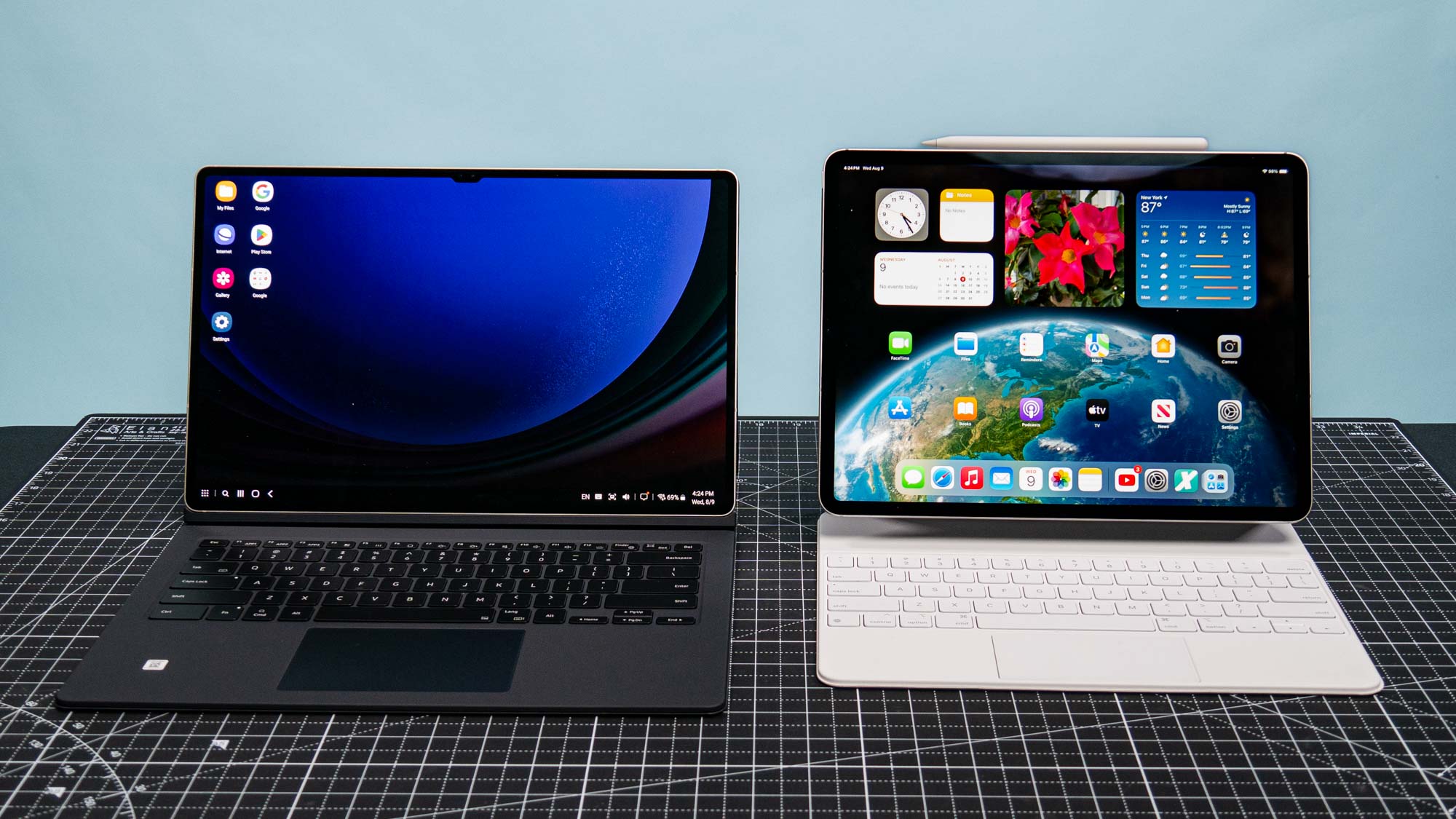
The iPad Pro 2022 measures 11.04 x 8.46 x 0.25 inches and weighs 1.5 pounds. When attached to the Magic Keyboard, the weight jump up to 3 pounds — which is heavier than laptops like the MacBook Air 2022 and Dell XPS 13 OLED 2022, which weigh 2.7 pounds each. That said, you’ll likely keep the iPad Pro on a flat surface when using it with the keyboard peripheral.
Buttons and ports remain the same as on the previous model. There’s a power button along the top right edge (when the iPad is held vertically like a sheet of paper) for locking the screen and using Touch ID, two buttons on the right side to raise or lower the volume and a single Thunderbolt 4/USB-C port on the bottom edge of the device. Quad speakers flank the tablet’s sides.
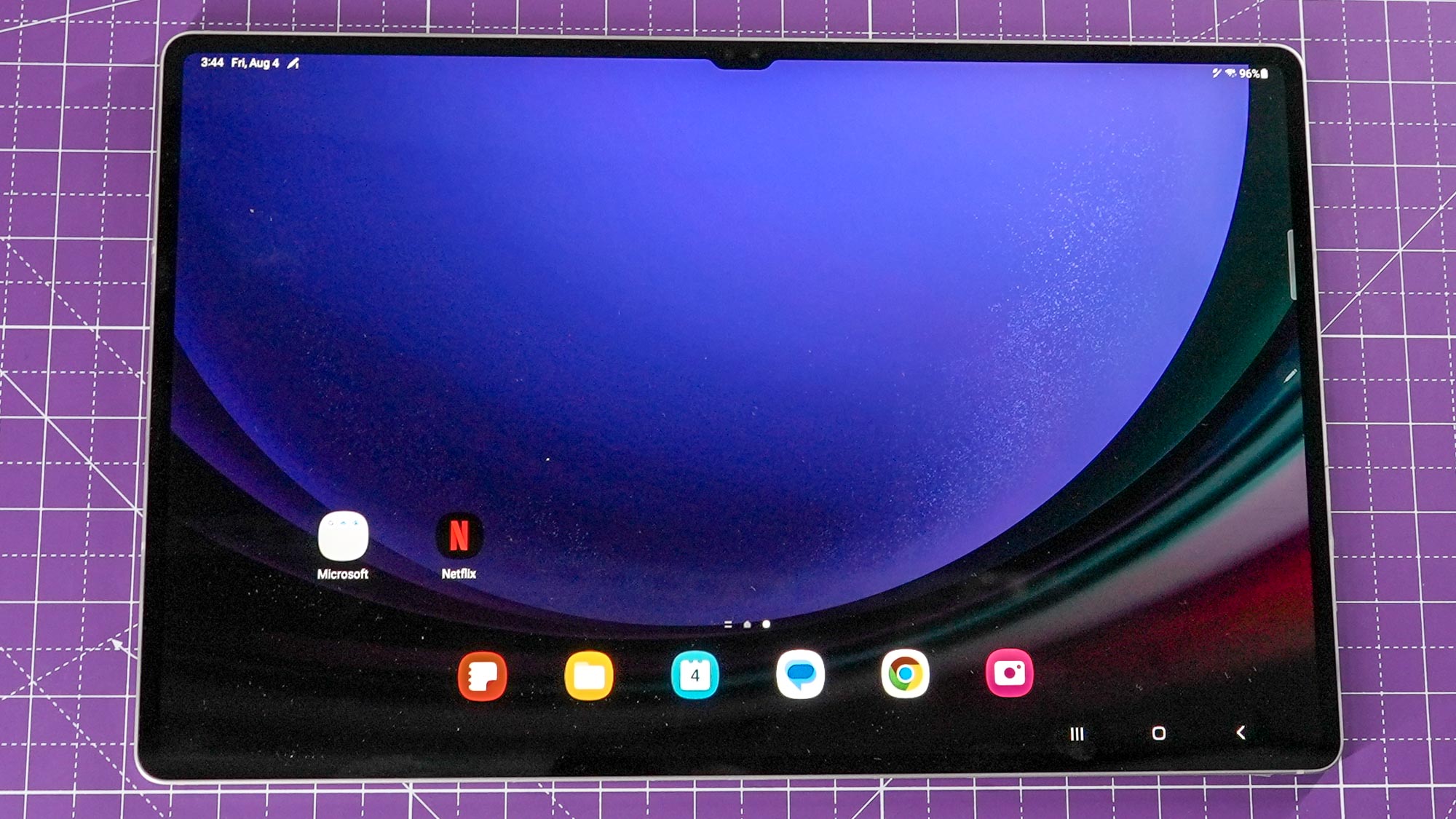
Like the Tab S8 Ultra, the Galaxy Tab S9 Ultra is a gargantuan tablet that literally overshadows its competitors. Even though it’s big at 12.85 x 8.21 x 0.22 inches, the slate only weighs 1.6 pounds. That’s relatively light, but due to the tablet’s unwieldy size, you’ll need to use two hands to hold it. Its size is both a strength and a weakness in that regard.
As before with the Tab S8 Ultra, the power and volume buttons rest along the slate’s right side. There’s also a microSD card slot near the bottom right side. Over on the back, you’ll find two rear-facing cameras and a magnetic strip to hold the included S pen. Quad speakers adorn the tablet’s sides, along with a single USB-C port. Unfortunately, there’s no headphone jack.
Neither tablet features a revolutionary new design but they also don’t need to. Regardless of which tablet you choose, you’re getting fetching slates that will look good no matter where you use them. In that sense, both are equal — though the larger Tab S9 Ultra impresses due to its size.
Samsung Galaxy Tab S9 Ultra vs iPad Pro: Display
The Galaxy Tab S9 Ultra features a huge 14.6-inch OLED display while the iPad Pro has a comparatively smaller 12.9-inch display. That might suggest Samsung's tablet has a superior display, but bigger doesn't necessarily mean better.
| Header Cell - Column 0 | Samsung Galaxy Tab S9 Ultra | iPad Pro (2022) |
|---|---|---|
| Nits (brightness) | 592 (adaptive) | 591 (adaptive) |
| sRGB | 117.7% | 117.1% |
| DCI-P3 | 83.4% | 82.4% |
| Delta-E | 0.17 | 0.3 |
When we got the Tab S9 Ultra into our testing lab and pointed our Klein 10-A colorimeter at it, we found its display does a good job of reproducing colors. In Natural mode, the display achieved 117.7% of the sRGB color gamut and 83.4% of the more demanding DCI-P3 color space (100% is most accurate, higher normally means more saturated colors) with a Delta-E score of 0.17 (closer to 0 is better). In Vivid mode, the display achieved 181.7% / 128.7 % / 0.18, respectively.
The Tab S9 Ultra’s display gets decently bright, especially when displaying HDR content. With adaptive brightness off, the display averaged 328 nits of brightness. Flipping adaptive brightness on bumps that to 592 nits of brightness. The tablet’s screen got as high as 834 nits of brightness when displaying HDR content on 10% of the display and 878 nits of brightness for 40% of the screen (765 nits for 100%).
How do these values compare to the iPad Pro 2022? As the table above shows, the Galaxy Tab S9 Ultra and iPad Pro 2022 are fairly similar across the board, though Apple’s premium tablet can get significantly brighter with HDR content — reaching as high as 1,577 nits of brightness across 40% of the screen.
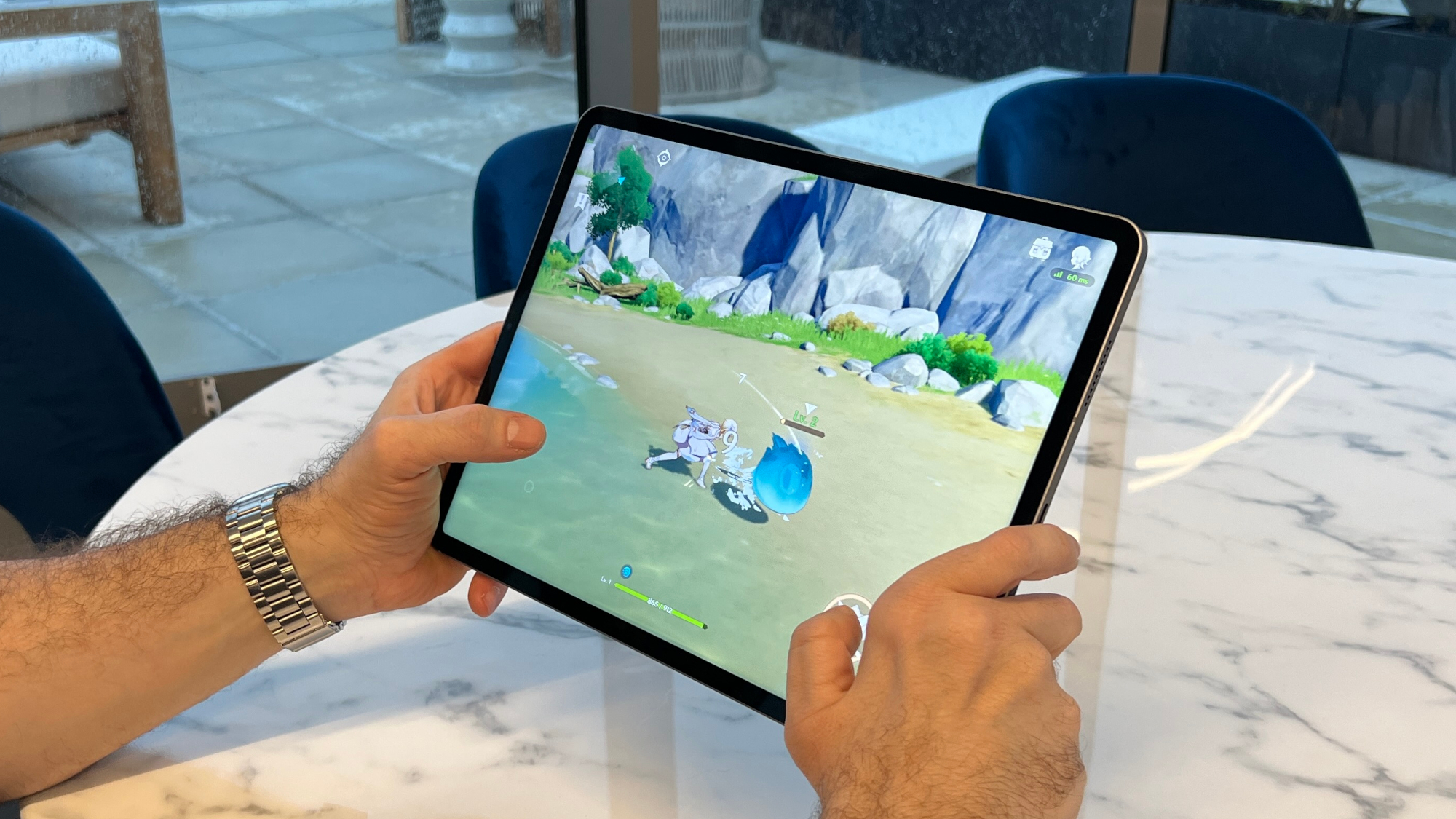
Both of the tablets' displays deliver lush visuals which are bright and colorful. The iPad Pro captures a narrow victory since its HDR capabilities outstrip the Tab S9 Ultra's, but this match is overall close.
Samsung Galaxy Tab S9 Ultra vs iPad Pro: Performance
The Samsung Galaxy Tab S9 Ultra packs a Qualcomm Snapdragon 8 Gen 2 processor and runs on Android 13. Phones like the Samsung Galaxy S23 Ultra feature the same chip and operating system.
Our Tab S9 Ultra review unit, which is the same as the entry-level model, came with 12GB of RAM. Thanks to that and the speedy Snapdragon 8 Gen 2 chip, the giant tablet performed beautifully for an Android device. While it delivers great performance, it can't quite match the iPad Pro.
| Header Cell - Column 0 | Samsung Galaxy Tab S9 Ultra | iPad Pro (2022) |
|---|---|---|
| Processor | Snapdragon 8 Gen 2 | MediaTek Dimensity 9000 |
| Geekbench 5 single-core CPU | 1,560 | 1,202 |
| Geekbench 5 multi-core CPU | 4,970 | 3,791 |
| 3DMark Wild Life Unlimited | 14,722 | 8,845 |
| Adobe Premiere Rush | 0:41 | N/A |
On the Geekbench 5 CPU benchmark, the Galaxy Tab S9 Ultra scored 1,560 on single-core and 4,970 on multi-core — both of which are commendable scores. However, the Apple M2-driven iPad Pro (1,862 / 8,500) crushed the Android tablet in CPU performance.
The Tab S9 Ultra scored 14,722 and hit 88 frames per second on the 3D Mark Wildlife Unlimited test, which measures graphics performance. The iPad Pro once again crushed the Samsung slate by scoring 25,219 and hitting 151 fps. Though Apple’s tablet outdid the Galaxy Tab S9 Ultra on this test, Samsung’s slate is very much capable of running demanding mobile games.
Lastly, in our Adobe Premiere Rush video transcoding test, the Galaxy Tab S9 took 41 seconds to complete the task. That’s pretty good, but the iPad Pro handled the task in a zippier 23 seconds.
Even if the Galaxy Tab S9 Ultra can’t match the M2-driven iPad Pro in performance, Samsung’s tablet is still one of the most powerful Android tablets we’ve tested.
Samsung Galaxy Tab S9 Ultra vs iPad Pro: Battery life
The Galaxy Tab S9 Ultra has decent battery life. But as with performance, it's outdone by the iPad Pro
| Header Cell - Column 0 | Time (mins:secs) |
|---|---|
| iPad Pro 2022 | 10:39 |
| Galaxy Tab S9 Ultra | 9:27 |
In our battery test, which tasks the tablet with endlessly surfing the Internet over Wi-Fi with its screen set to 150 nits of brightness, the Tab S9 Ultra lasted for 9 hours and 27 minutes at a 60Hz refresh rate. On the other hand, the iPad Pro lasted for over an hour longer — though it has a smaller display and runs on the energy-efficient Apple M2 chip.
There's not much more to say here. The iPad Pro can literally outlast the Galaxy Tab S9 Ultra.
Samsung Galaxy Tab S9 Ultra vs iPad Pro: Keyboard and pencil
The Apple Magic Keyboard ($349) and Apple Pencil 2 ($129) might be pricy but they’re two of my favorite tablet peripherals out there. The former gives the iPad Pro laptop-like functionality while the latter lets you write or draw on the tablet. The floating cantilever design allows you to get the perfect viewing angle. The spacious keyboard lets you type comfortably for hours, while the trackpad is both smooth and responsive.
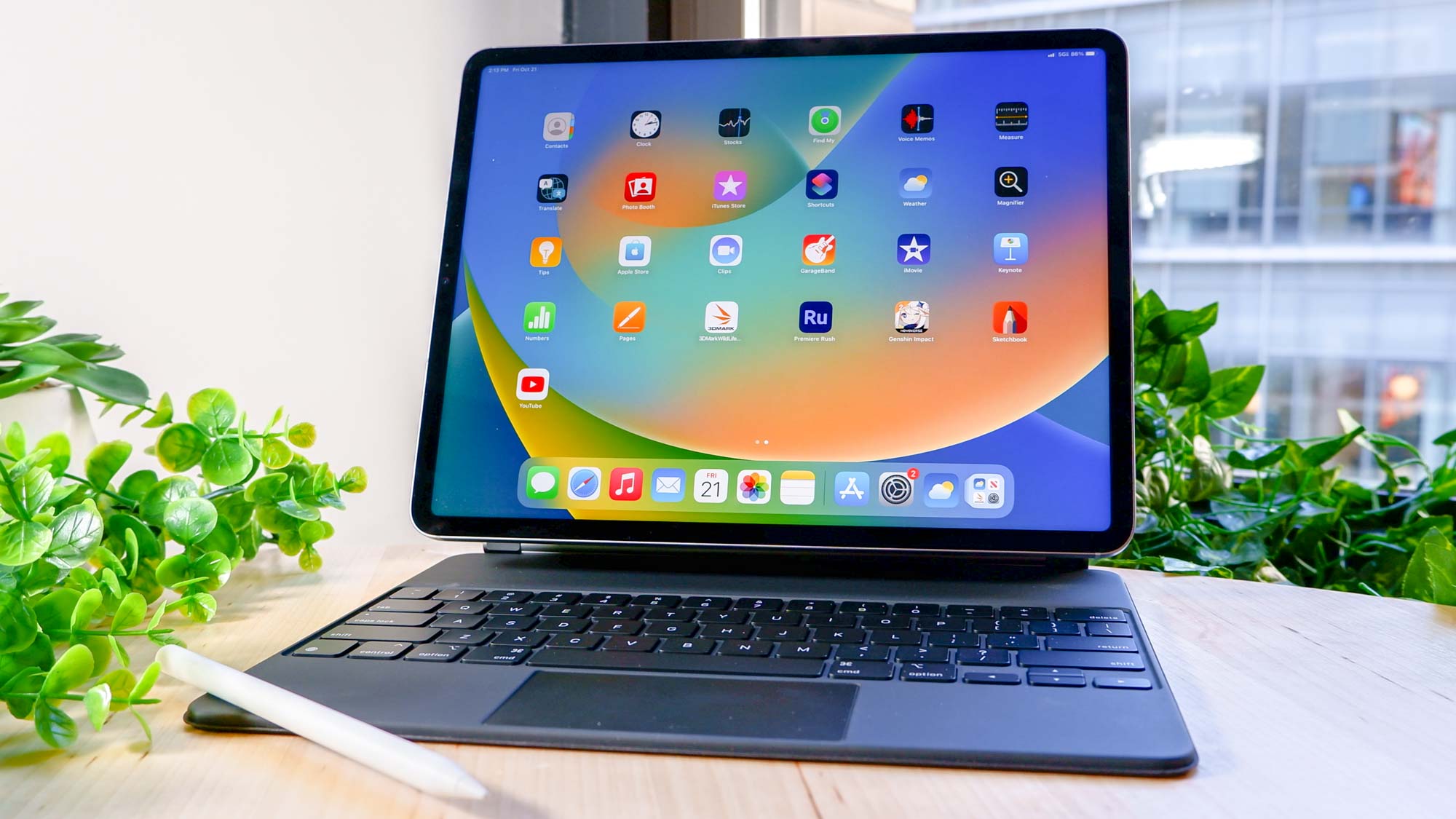
Similarly, the Tab S9 Ultra has an optional Book Cover Keyboard with S Pen for $349. As with the iPad Pro’s optional peripherals, spending an extra $349 on top of the $1,199 you've spent on the tablet will make your wallet cry.
Price aside, the peripherals are indispensable. The large keyboard feels good to type on and gave my big hands enough space to move. I also liked how the back cover has a compartment for the S Pen. The Book Cover Keyboard looks great on the Tab S9 and keeps it protected against accidental drops. The updated S Pen now charges whether you place it up or down on the magnetic strip, which is a nice touch.
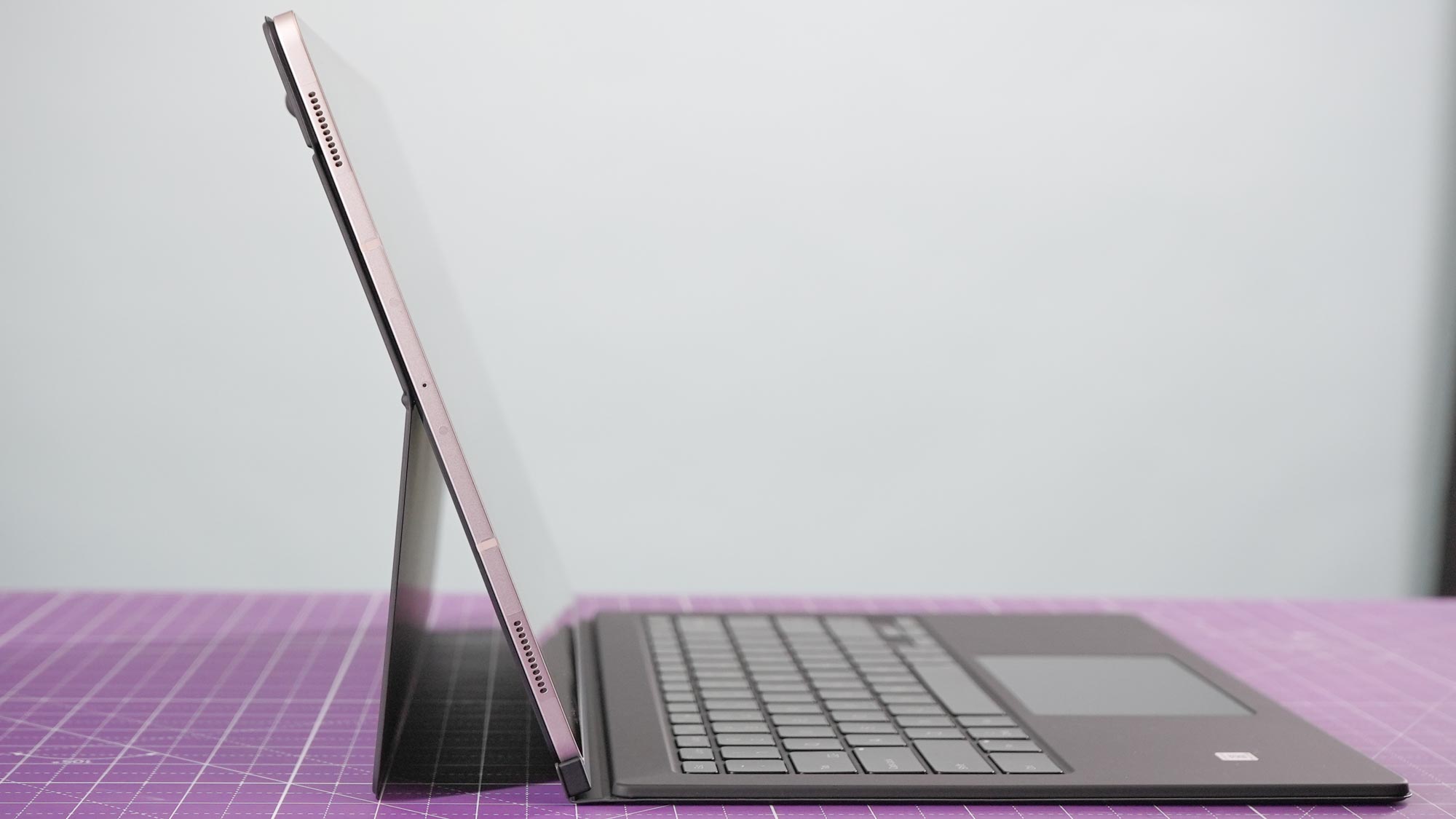
While the Book Cover Keyboard is functional, it’s not a match for the Apple Magic Keyboard. The Magic Keyboard keeps the iPad Pro locked in place and the keyboard portion provides a solid and sturdy base. Samsung’s peripheral feels flimsy in comparison. Because the kickstand on the Book Cover Keyboard is so thin, it can sometimes be difficult to prop the tablet up without it falling over due to its size. I could’ve forgiven the kickstand's finicky nature if the peripheral was priced lower, but for $349, I expect a product on par with Apple's Magic Keyboard.
Samsung Galaxy Tab S9 Ultra vs iPad Pro: Webcam
Both tablets feature the same cameras as their respective older models. Given how each device’s cameras took sharp pictures, there’s little to complain about here.
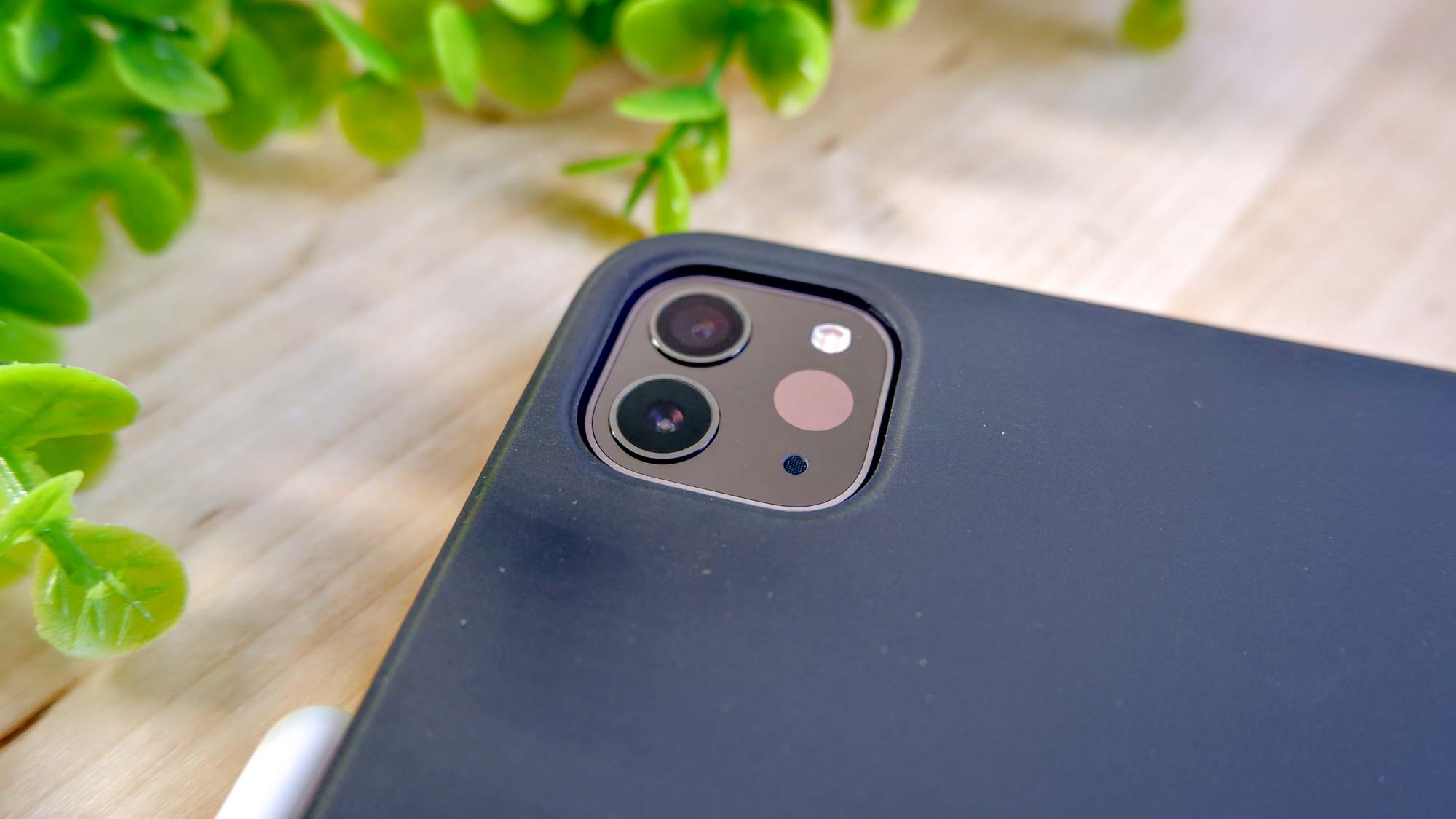
The iPad Pro’s 12MP front-facing camera will make you look presentable during video calls or if you’re inclined to take selfies. Similarly, the 12MP and 10MP rear cameras also snap excellent photos. The main downside with the front camera is that it’s positioned on the short edge of the tablet’s display. I’d prefer the camera on the longer side, which would be easier for video calls — especially with the Magic Keyboard attached to the iPad Pro.
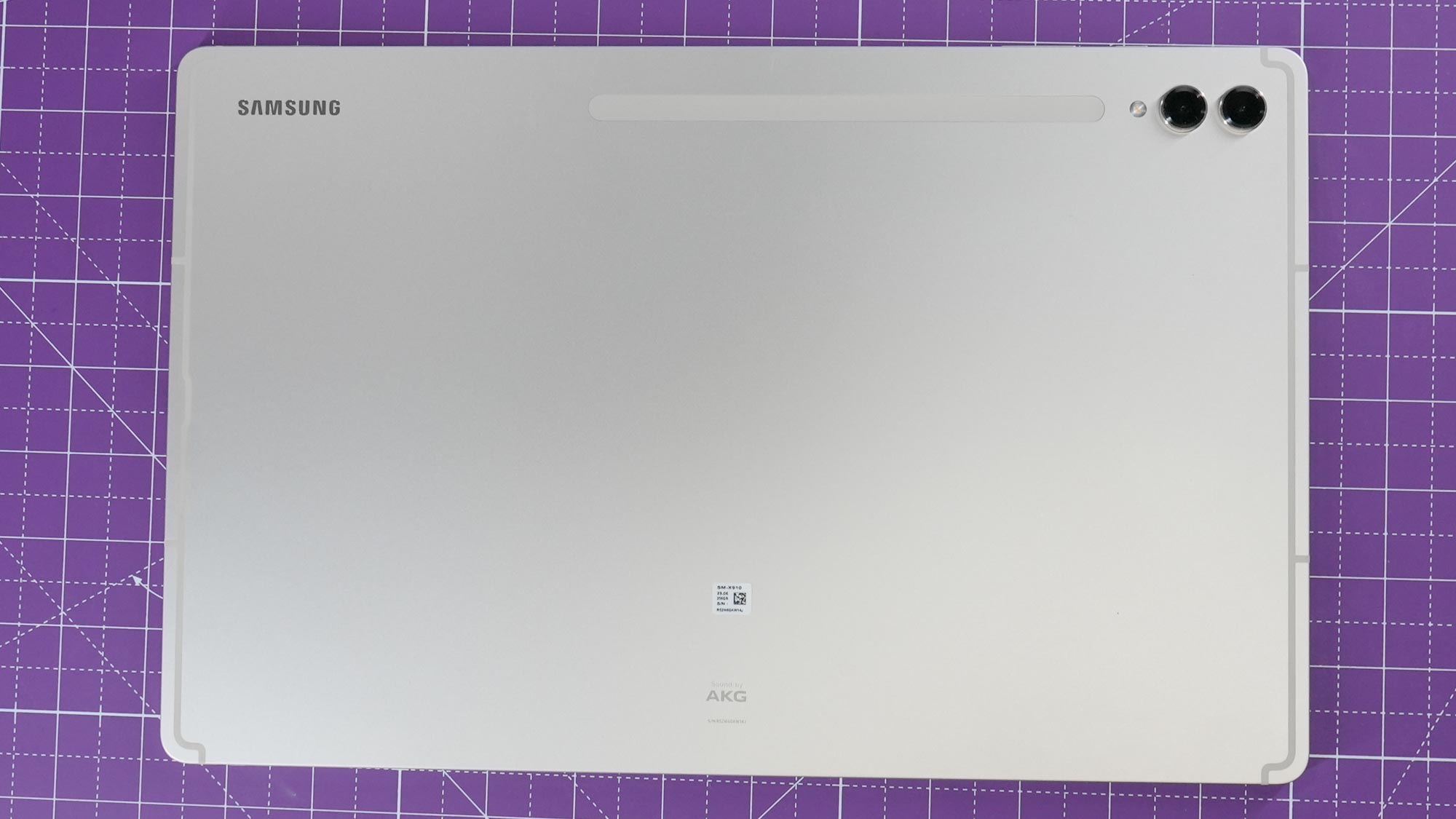
Like the Galaxy Tab S8 Ultra, the Tab S9 Ultra has two front-facing 12MP cameras capable of shooting regular and ultrawide shots. Over on the back, you’ll find 13MP and 6MP cameras. All the tablet’s cameras can record video at up to 4K resolution and at 60 frames per second.

As you can see from the image above, the rear cameras on the Galaxy Tab S9 Ultra deliver sharp and vibrant images. All the images in the background are clearly discernable, and you have to zoom in pretty close before you start seeing noticeable grain. I took the photo below with the front-facing cameras, which did a good job of capturing all the wrinkles in my un-ironed shirt.
In my estimation, both cameras deliver solid overall images thanks to their respective front and rear-facing cameras. Since neither tablets take better photos than the other, let's call this one a draw.
Samsung Galaxy Tab S9 Ultra vs iPad Pro: Bottom line
So which tablet should you get? As is typical for face-offs between Apple and Samsung products, it comes down to personal preference and the ecosystem you're invested in. If you like Apple, get the iPad Pro. Similarly, if you're into Samsung or Android devices, then the Galaxy Tab S9 Ultra is for you.
If you're not married to a particular ecosystem and want a tablet with a giant display, then get the Galaxy Tab S9 Ultra is for you. If you value performance and want a better keyboard peripheral, then the iPad Pro is the better option.
More from Tom's Guide
Sign up to get the BEST of Tom's Guide direct to your inbox.
Get instant access to breaking news, the hottest reviews, great deals and helpful tips.

Tony is a computing writer at Tom’s Guide covering laptops, tablets, Windows, and iOS. During his off-hours, Tony enjoys reading comic books, playing video games, reading speculative fiction novels, and spending too much time on X/Twitter. His non-nerdy pursuits involve attending Hard Rock/Heavy Metal concerts and going to NYC bars with friends and colleagues. His work has appeared in publications such as Laptop Mag, PC Mag, and various independent gaming sites.
